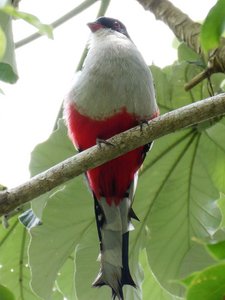Advertisement
Published: July 22nd 2018

 Las Terrazas 1960s Unesco Biosphere Reserve (15)
Las Terrazas 1960s Unesco Biosphere Reserve (15)
Cuba's National Bird - The Cuban trogon (Priotelus temnurus) named in different regions of Cuba' tocororo'We joined our co-travellers for breakfast of fruit, vegies, chick peas, pancakes, guava pie, eggs and bread roll. Fresh juices and coffee was all the go as well. At 8.30am we hopped on the air-conditioned bus. Dany gave us water to fill our bottles each morning and throughout the day.
On the way to Soroa we stopped at a couple of community art projects. Firstly to
Callejon de Hammel where local resident
Salvador Gonzáles Escalona has painted and decorated a pedestrian alleyway which has now become a cultural focal point with workshops for young Cuban children to learn painting.
Next in the outskirts of Havana we visited the fishing village of
Jaimanitas and the home of the famous artist
Jose Fuster. Fuster has made his entire home, and much of the surrounding neighbourhood, into an artwork using tiles in mosaic forms. Now referred to as
Fusterlandia, it is a unique work of public art with over 80 houses decorated with ornate murals and domes to suit the personality of each of Fuster’s neighbours.
Then we visit the mountain community of Las Terrazas which was built as a reforestation project in the 1960s and is now a Unesco Biosphere Reserve. We had time in the afternoon for a walk around the town to meet the friendly locals. One member of our group went for a swim in the pretty San Juan mountain stream. There was also art, woodwork and pottery studios that were open to the public.
We decided to have a coffee at the local open air restaurant and access the wifi. Whilst there, we had a torrential tropical down-pour which lasted 20 minutes. Not long after it rained, all was dried up and we continued our visit.
It was a beautiful drive with mountains either side of the road with the occasional village house. During this leg of the trip, we listened to a video on Fidel Castro which was fascinating. The USA have built Fidel into a monster over the years, particularly those noisy few in Miami. He was anything but a monster. His strong, almost singular approach with a “revolutionary” political view, was shared by
many developing countries in Africa and many others. He was almost a benevolent dictator but very like Nelson Mandela. He helped many countries with their struggle for independence and socialist strength. This is probably why the 2 men got on so well. Their views were similar. Our fellow-traveller from the USA was astonished at how different she had been taught at school about Castro. She said the children of the USA had been lied to all these years, as other people in the world have. The USA have had a paranoia towards Cuba and embargoes continue to this day.
The place we stopped for lunch was an open air restaurant which served up a huge roast pork or rabbit, rice and bean, cucumber & avocado salad and fresh fruit.
We eventually reached the tiny settlement of Soroa, which for many is the prettiest area of the region. Soroa which is a beautiful area in the mountains with quite a few interesting things to see.
In the village, many of the homes rent out their rooms to tourists, a little
like AirBNB. Five of us stayed at one home and the other 2 at another home. They provided us with dinner and breakfast, again feeding us way too much….. but it was all very fresh and home-made.
As soon as we found our rooms, Tracy and I went for an hour walk, coming back absolutely drenched from the humidity. A shower, another big dinner (Tom & I shared this time) and settling down to a game of dominoes (which the locals play extensively), was the order of the evening. I hadn’t played dominoes for decades!
Advertisement
Tot: 0.09s; Tpl: 0.021s; cc: 11; qc: 28; dbt: 0.0352s; 1; m:domysql w:travelblog (10.17.0.13); sld: 1;
; mem: 1.1mb























